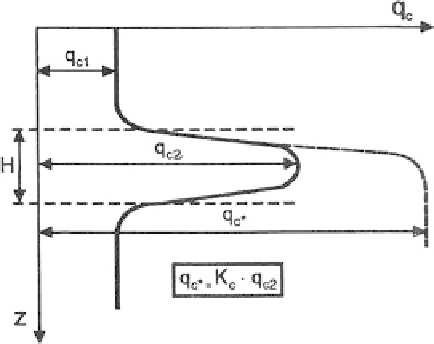Environmental Engineering Reference
In-Depth Information
resistance within thin stiff layers is a function of the thickness of the layer as well as the
stiffness of the layer relative to that of the surrounding soil. The relative stiffness of the
layers is reflected by the change in cone resistance from the soft surrounding soil (q
c1
) to
that in the stiff soil layer (q
c2
). Based on this work, a corrected cone resistance (q
c*
) is
derived as:
(6.21)
q
K. q
c*
c
c2
where K
c
a correction factor for the cone resistance as a function of the layer thickness.
The corrections recommended by Vreugdenhil et al. (1994) were considered by Lunne
et al. (1997) to be rather large, so they recommended a more conservative correction
which is shown in Figure 6.26 and given by the following expression:
2
H
K
c
05
1000
.
145
.
10
.
(6.22)
where H
layer thickness, in mm; q
c2
cone resistance in the layer; q
c1
cone resist-
ance in the soil surrounding the layer.
The CPT or CPTU may not be able to penetrate well compacted earthfill. They will
refuse on gravelly soils.
CPT or CPTU probes through dam cores should be backfilled with cement - bentonite
grout inserted by pushing the rods without the cone on them or a steel pipe down the hole,
and injecting the grout at low pressures while withdrawing. Care should be taken to avoid
hydraulic fracture and in some situations it may be judged too risky to probe through the
core, or preferable to leave the probe hole ungrouted, rather than risk hydraulic fracture.
6.1.7.2
Vane shear
The vane shear may be used to measure the undrained strength of very soft to firm (S
u
less
than about 60 kPa) cohesive soils. The equipment and procedures are described in many
texts (e.g. Clayton et al., 1995; Walker, 1983).
It is normal practice to correct the strength measured by the vane to account for
anisotropy and rate of shearing. Bjerrum (1973) developed a method for doing this using
Figure 6.26.
Suggested correction to CPT cone resistance in thin sand layers (Lunne et al., 1997; based
on Vreugdenhil et al., 1994).



